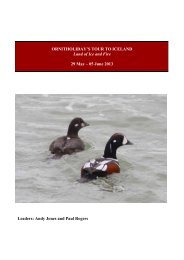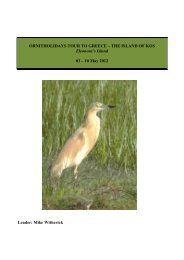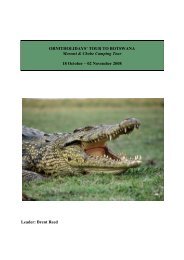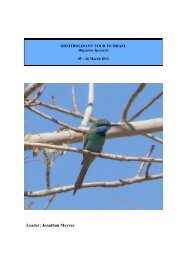Download 2014 Brochure (.pdf) - Ornitholidays
Download 2014 Brochure (.pdf) - Ornitholidays
Download 2014 Brochure (.pdf) - Ornitholidays
You also want an ePaper? Increase the reach of your titles
YUMPU automatically turns print PDFs into web optimized ePapers that Google loves.
B U L G A R I A<br />
Bulgaria at Leisure<br />
The Black Sea Flyway<br />
Sunday 07 September – Sunday 14 September <strong>2014</strong><br />
Principal Leader: Dobromir Domuschiev<br />
<strong>2014</strong> Cost £1,599 single room supplement £100<br />
Sofia<br />
BULGARIA<br />
Bourgas<br />
Varna<br />
Pomorie<br />
ur early autumn tour to Bulgaria concentrates on the return migration. It exploits the fact that the Black Sea coast of Bulgaria represents a major<br />
O flyway. We will stay at Pomorie, close to the port city of Burgas, which is widely recognised to be a migration hotspot due to the fact that two<br />
major southward migration flyways cross each other in the general vicinity. From our base, we will be able to visit key locations within this ‘crossroads’<br />
zone and also take in a range of different habitats. Of these, perhaps the most important are the three lakes of differing character – Atanasova,<br />
Vaya and Mandra – that surround the city of Burgas. They and their adjacent wetlands are host to huge numbers of birds during the autumn migration.<br />
More than 340 bird species have been recorded in this area. As with all migration watching much depends on weather conditions, but early September<br />
is widely held to be the prime time for the autumn passage in this part of Europe. Not only should we see a large number of species, but also many<br />
of those species will be represented by good numbers of birds, from pelicans to pipits, storks to swallows and waders to wagtails. Hopefully, the<br />
highlight will be vast flocks of White Storks and White Pelicans, which should reach their peak migration at this time of year. We shall also be<br />
particularly keen to watch the movement of raptors, such as Lesser Spotted Eagle and Levant Sparrowhawk. This will be <strong>Ornitholidays</strong>’ 15th tour to<br />
this region in the late summer and it will be run in a relaxed style fitting our ‘at leisure’ and ‘one-stop’ holidays.<br />
White Pelicans migrating<br />
ITINERARY<br />
Day 1<br />
We take a flight from London and fly directly to<br />
Bourgas. Here we will be met by our local guide<br />
and a short drive brings us to Pomorie, our base<br />
for this one-stop tour.<br />
Days 2 to 7<br />
During our stay we will visit a number of different<br />
sites, some of them probably more than once.<br />
This will certainly be true of the Pomorie Lake,<br />
particularly its saltpans and tamarisk scrub that<br />
are a short walk from the hotel – ideal for those<br />
who like a spell of pre-breakfast bird watching.<br />
Duck, wader, gull and tern species will be the<br />
focus of interest here, as well as looking for<br />
migrant Red-breasted Flycatcher, Red-backed<br />
Shrike, Lesser Whitethroat and Yellow Wagtail.<br />
Atanasova Lake, on the northern outskirts of<br />
Burgas, is another area of working saltpans. It<br />
has also been recognised as a Ramsar site. Huge<br />
numbers of migrants pass through or over it. The<br />
lake is renowned as the best place in Bulgaria for<br />
watching and studying the autumn migration.<br />
Twelve globally threatened species occur here,<br />
including Dalmatian Pelican and Ferruginous<br />
Duck. Apart from the last species, other ducks to<br />
be seen include Common and Ruddy Shelduck,<br />
Garganey, Northern Shoveler, Eurasian Wigeon<br />
and Northern Pintail. Our list of waders here is<br />
likely to include Black-winged Stilt, Pied Avocet,<br />
Black-tailed Godwit, Broad-billed, Marsh and<br />
Curlew Sandpipers, Kentish and Little Ringed<br />
Plovers as well as Red-necked Phalarope. Here<br />
we hope to find Caspian and Black Terns, as well<br />
as Slender-billed, Little and Mediterranean Gulls.<br />
The reed-fringed dykes of its margins offer<br />
temporary refuge to a range of migrating birds,<br />
from Little and Baillon’s Crakes to Bearded<br />
Reedlings and Eurasian Penduline Tits.<br />
Lake Vaya is the largest natural lake in Bulgaria.<br />
It is also a Ramsar site and is a popular staging<br />
post for thousands of White Pelicans, with<br />
smaller numbers of Dalmatian Pelicans, as well<br />
as waders such as Spotted Redshank, Ruff and<br />
Wood Sandpiper. Here there are thousands of<br />
Great Cormorant and good numbers of Pygmy<br />
Cormorant. Herons and egrets, ducks and<br />
grebes are also well represented. Small flocks of<br />
Glossy Ibis and Spoonbill are regularly seen here<br />
at this time of the year. Cetti’s Warbler and Zitting<br />
148<br />
For a previous tour report or further information please call: 01794 519445








